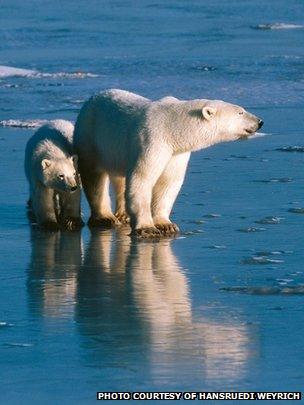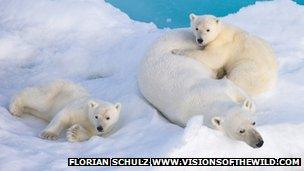DNA reveals polar bear's ancient origins
- Published

Polar bears spend most of their time on frozen Arctic sea ice
The polar bear is much older than previously thought, according to new genetic evidence.
DNA studies suggest the Arctic predator split from its ancestor, the brown bear, about 600,000 years ago.
Previous estimates put the polar bear at about 150,000 years old, suggesting the mammal adapted very rapidly to Arctic life.
Conservationists say the new study, published in <link> <caption>Science</caption> <altText>Science</altText> <url href="http://www.sciencemag.org/" platform="highweb"/> </link> , has implications for bear conservation.
Polar bears are listed as threatened under the US Endangered Species Act.
Conservationists say their survival is at risk, mainly due to the loss of the Arctic sea ice on which they spend much of their lives.
Dr Frank Hailer of the German Biodiversity and Climate Research Centre in Frankfurt, who led the international study, said the genetic information shed new light on conservation issues.
"It fundamentally changes our understanding of polar bears and their conservation today," he told BBC News.
"They have survived previous warm phases but they carry scars from these times - they must have been close to extinction at times."
Nuclear DNA
The researchers looked at DNA from modern bears to study the history of the species, analysing genetic information from the cell nucleus of more than 40 brown, black and polar bears.
Past work has relied mainly on mitochondrial DNA, the fragments of genetic material contained within tiny cell components called mitochondria.
The latest findings suggest the polar bear evolved in the mid Pleistocene, about 600,000 years ago. This scenario paints a new picture of the bear's evolutionary history.
The mammal would have had more time to colonise and adapt to life in the high Arctic, and lived through various cycles of warming and cooling.

Polar bear and cubs on drift ice
The polar bear's lack of genetic diversity suggests that changes in the environment, such as warm phases, led to dramatic falls in numbers at times.
The researchers say polar bears face many other threats to their survival today, including habitat destruction, hunting and the effects of environmental pollutants.
Writing in Science, they explain: "Although polar bears have persisted through previous warm phases, multiple human-mediated stressors (eg habitat conversion, persecution, and accumulation of toxic substances in the food chain) could magnify the impact of current climate change, posing a novel and likely profound threat to polar bear survival."
Commenting on the research, Dr Steven Amstrup, chief scientist of <link> <caption>Polar Bears International</caption> <url href="http://www.polarbearsinternational.org/" platform="highweb"/> </link> , said he suspected the age of the polar bear was not entirely settled yet.
Even if they did split from their ancestor 600,000 years ago, they would have lived through only two periods noticeably warmer than today, he said, and spent most of their existence in cooler times.
He added: "It's continuing evidence that polar bears are adapted to a cold environment and they haven't experienced anything of the warming that we are likely to experience in the next 100 years."
- Published7 July 2011